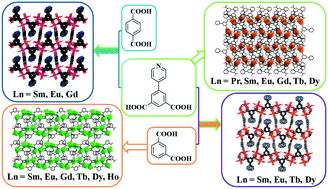2D and 3D lanthanide metal–organic frameworks constructed from three benzenedicarboxylate ligands: synthesis, structure and luminescent properties†
Abstract
Nineteen lanthanide–benzenedicarboxylate complexes were obtained under similar hydrothermal conditions: [Ln(IP-Py)(HIP-Py)(H2O)2]n (Ln = Pr (1), Sm (2), Eu (3), Gd (4), Tb (5), Dy (6)), [Ln4(IP)6(H2O)4(DMF)·DMF·mH2O]n (Ln = Sm, m = 1 (7), Eu, m = 1.5 (8), Gd, m = 1.5 (9), Tb, m = 1.5 (10), Dy, m = 1 (11), Ho, m = 1.5 (12)), [Ln2(IP-Py)2(IP)(H2O)4·H2O]n (Ln = Sm (13), Eu (14), Tb (15), Dy (16)) and [Ln2(IP-Py)2(TP)(H2O)4·H2O]n (Ln = Sm (17), Eu (18), Gd (19)), where: H2IP-Py = 5-(4-pyridyl)-isophthalic acid), H2IP = isophthalic acid, H2TP = terephthalic acid. Complexes 1–6 exhibit a two-dimensional layered structure based on H2IP-Py. For 7–12, the Ln3+ ions are linked into one-dimensional chains with two triple-stranded helices of opposite handedness and further constructed into a two-dimensional layer by coordination of the IP2− ligands. For complexes 13–16 and 17–19, a similar two-dimensional layer was formed by coordination of Ln3+ and IP-Py2−, and three-dimensional pillar-layered frameworks were formed due to the layers bridged by the auxiliary IP2− or TP2− ligand, respectively. Most complexes show the characteristic narrow-banded lanthanide 4fN–4fN emission in combination with luminescence from the ligands, with the relative contribution depending on the energy transfer from the ligands to the lanthanides. The ligands play an important role in the sensitization of the lanthanide emission. The onset of the main excitation band for the Eu3+ complexes is found at the lowest energy for 14, enabling excitation by near-UV LEDs. The complexes containing the technologically relevant ions for (back) lighting applications, Tb3+ (green) and Eu3+ (red), are evaluated in detail in terms of luminescence lifetime and thermal stability. The emission intensity of selected Eu3+ and Tb3+ compounds is stable up to room temperature.



 Please wait while we load your content...
Please wait while we load your content...